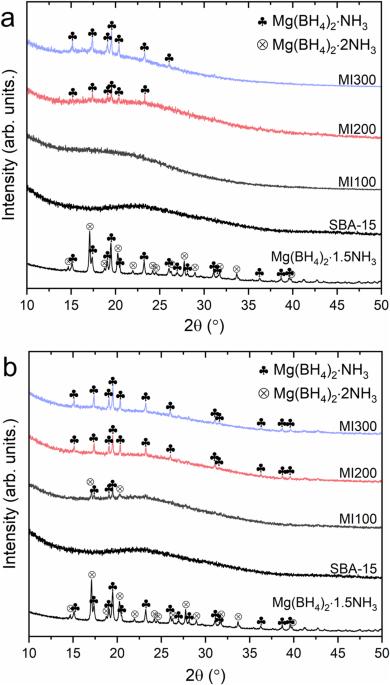介孔二氧化硅支架中的氨镁硼氢化复合电解质的纳米融合
IF 7.5
Q1 MATERIALS SCIENCE, MULTIDISCIPLINARY
引用次数: 0
摘要
镁离子导电材料的改进对于新型镁固态电池的开发非常重要。在此,我们研究了导电性最强的镁电解质之一--(Mg(BH4)2-NH3)x(Mg(BH4)2-2NH3)1-x 复合材料的纳米细化效果。通过熔融渗透,在介孔二氧化硅支架(SBA-15,孔径 5.8 nm)中合成了纳米封闭 Mg(BH4)2-1.47NH3。研究了不同的孔隙填充度,从 100% 到 300%。固态 11B 核磁共振分析证实,通过纳米注塑,成功稳定了 Mg(BH4)2-1.47NH3 的高动态共晶熔融态。密闭样品表现出显著的热稳定性,可在约 100 °C 的温度下保持完整性,并且共晶熔融复合材料在合成后室温下储存五个月内不会再结晶。值得注意的是,在密闭样品中,200% 孔隙填充显示出良好的 Mg2+ 离子电导率,范围在 9.1 × 10-6 到 2.7 × 10-4 S cm-1 之间,在 32 到 80 °C 的温度下,活化能低至 0.69 eV。此外,还发现该化合物在 70 °C 时具有 7.93 × 10-11 S cm-1 的低电子电导率,从而使离子传输数接近一。改进镁基离子导电材料对于开发镁固态电池非常重要。在这里,镁电解质被纳米限定在介孔二氧化硅支架中,从而改善了离子传输特性和稳定性。本文章由计算机程序翻译,如有差异,请以英文原文为准。

Nanoconfinement of an ammine magnesium borohydride composite electrolyte in a mesoporous silica scaffold
Improvements of magnesium ionic conducting materials are important for the development of novel magnesium solid-state batteries. Here we investigate the effect of nanoconfinement of one of the most conductive magnesium electrolytes − the (Mg(BH4)2·NH3)x(Mg(BH4)2·2NH3)1−x composite. The synthesis of nanoconfined Mg(BH4)2·1.47NH3 in a mesoporous silica scaffold (SBA-15, pore size 5.8 nm) is achieved through melt infiltration. Various degrees of pore filling are investigated, ranging from 100 to 300 %. Solid-state 11B nuclear magnetic resonance analysis confirms the successful stabilization of the highly dynamic eutectic molten state of Mg(BH4)2·1.47NH3 through nanoconfinement. The confined sample exhibits notable thermal stability, maintaining integrity up to approximately 100 °C, and the eutectic molten composite does not recrystallize within five months after synthesis, upon storing at room temperature. Notably, among the confined samples, 200 % pore filling displays promising Mg2+ ionic conductivity within the range of 9.1 × 10−6 to 2.7 × 10−4 S cm−1 and a low activation energy of 0.69 eV at temperatures from 32 to 80 °C. Furthermore, the compound was found to have a low electronic conductivity of 7.93 × 10−11 S cm−1 at 70 °C resulting in an ionic transport number close to unity. Improving magnesium-based ionic conducting materials is important for developing magnesium solid-state batteries. Here, magnesium electrolytes are nanoconfined in a mesoporous silica scaffold which improves the ionic transport properties and stability.
求助全文
通过发布文献求助,成功后即可免费获取论文全文。
去求助
来源期刊

Communications Materials
MATERIALS SCIENCE, MULTIDISCIPLINARY-
CiteScore
12.10
自引率
1.30%
发文量
85
审稿时长
17 weeks
期刊介绍:
Communications Materials, a selective open access journal within Nature Portfolio, is dedicated to publishing top-tier research, reviews, and commentary across all facets of materials science. The journal showcases significant advancements in specialized research areas, encompassing both fundamental and applied studies. Serving as an open access option for materials sciences, Communications Materials applies less stringent criteria for impact and significance compared to Nature-branded journals, including Nature Communications.
 求助内容:
求助内容: 应助结果提醒方式:
应助结果提醒方式:


